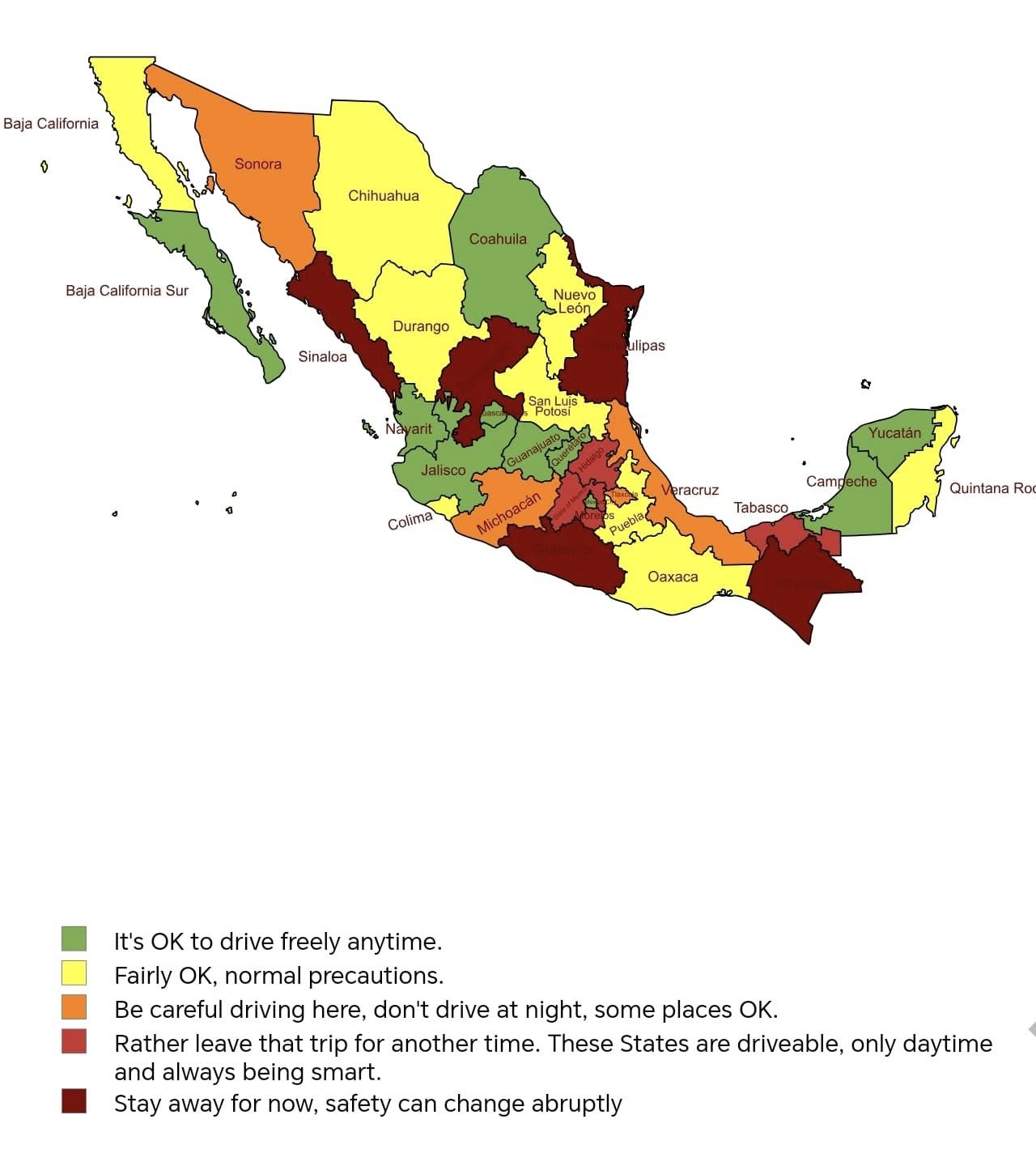Flying vs. Driving to Mexico: How We Moved With 6 Suitcases and a Cat

Moving to Mexico: Should You Fly or Drive?
If you’re planning a move to Mexico, one of the first big questions you’ll face is: should you drive or fly? It’s a decision every expat wrestles with—balancing cost, convenience, and sanity.
When we decided to relocate to Mérida, Mexico, that question defined our entire moving plan. In the end, we chose to fly—with six suitcases and one very confused cat named Leo. Here’s what we learned about both options, what it really costs, and how to choose what’s right for you.
Be sure to check out our latest podcast episode, "How We Moved to Mexico with 6 Suitcases & a Cat | This Might Be a Bad Idea Podcast," for a deeper dive into our own move to Mérida and the factors that shaped our choices.
Our Experience: Flying to Mérida With a Cat (and Chaos)
When we started packing, we thought we were traveling light. Spoiler alert: six suitcases are not light.
After forty years of collecting “stuff,” we were ready to start fresh. We sold or donated nearly everything and condensed our life into luggage that would fit on a plane. The only non-negotiable? Leo, our cat, who handled his first international flight like a tiny, furry hero.
We had considered driving—until we realized the time, distance, and stress that came with it. A week-long road trip through multiple borders sounded more like a test of endurance than a fresh start.
Why We Chose to Fly: Factors Influencing Our Decision
Several factors influenced our decision to fly rather than drive to Mexico. Firstly, the sheer distance was a significant deterrent. Driving from our home in the United States to Mérida would have been a multi-day journey, requiring extensive planning, multiple overnight stays, and the potential for unexpected delays.
Secondly, safety concerns played a crucial role. While many people drive through Mexico without incident, we were aware of the potential risks associated with long-distance travel, particularly with a car full of belongings. We heard stories about potential encounters with drug cartels, corrupt police officers, and vehicle theft. While we tried not to let fear dictate our decisions, we also wanted to minimize any potential risks.
Thirdly, the comfort and well-being of our cat, Leo, was a major consideration. A long car ride would have been incredibly stressful for him, even with frequent stops. Flying, while not ideal, seemed like a faster and more controlled environment, especially with the help of veterinarian-prescribed sedatives to keep him calm.
Finally, we weighed the costs involved. While driving might seem cheaper on the surface, we factored in gas, tolls, accommodation, meals, and potential vehicle maintenance. When compared to the cost of flights and baggage fees, the difference was not as significant as we initially thought. Taking all these factors into consideration, flying emerged as the more practical and sensible option for our specific circumstances.
Driving to Mexico: Potential Benefits and Drawbacks for Expats
Driving to Mexico offers several potential benefits for expats. Perhaps the most significant advantage is the ability to transport a larger quantity of personal belongings. If you're planning to bring furniture, appliances, or other bulky items, driving might be the only feasible option. This can be particularly appealing if you're attached to your possessions or if you're starting a business that requires specific equipment.
Driving also allows for greater flexibility and control over your journey. You can choose your own route, stop at interesting places along the way, and explore different parts of Mexico at your own pace. This can be a great way to immerse yourself in the culture and get a feel for the country before settling in your chosen destination.
However, driving to Mexico also presents several drawbacks. As mentioned earlier, safety is a major concern. Certain areas of Mexico are known for high crime rates, and it's essential to research your route thoroughly and take precautions to minimize risks. This might involve traveling during daylight hours, avoiding certain areas altogether, and ensuring your vehicle is in good working condition.
The cost of driving can also be higher than anticipated. Gas prices in Mexico can be comparable to those in the United States or Canada, and toll roads are common. Accommodation and meals along the way can add up quickly, and there's always the risk of unexpected vehicle repairs. Finally, driving can be physically and mentally demanding, especially over long distances. It's crucial to be well-rested and prepared for the challenges of driving in a foreign country.
Flying to Mexico: Potential Benefits and Drawbacks for Expats
Flying to Mexico offers several advantages for expats, primarily convenience and speed. A flight from the United States or Canada to Mexico can take just a few hours, saving you days of travel time compared to driving. This can be particularly appealing if you're on a tight schedule or if you simply prefer a quicker and more comfortable journey.
Flying also eliminates the stress and potential risks associated with driving through unfamiliar territory. You can relax and enjoy the flight, knowing that you'll arrive at your destination relatively quickly and safely. This can be especially beneficial if you're traveling with children or pets, or if you're simply not comfortable driving long distances.
However, flying also has its drawbacks. The most significant limitation is the amount of luggage you can bring. Airlines typically have strict weight and size restrictions, and excess baggage fees can be expensive. This can be a major challenge if you're planning to bring a lot of personal belongings, or if you simply don't want to part with certain items.
Flying can also be stressful for pets. The noise, altitude, and unfamiliar environment can be unsettling, and there's always the risk of your pet becoming anxious or sick during the flight. It's essential to consult with your veterinarian before flying with your pet and take any necessary precautions to ensure their comfort and well-being.
Cost Comparison: Driving vs. Flying (Gas, Tolls, Flights, Baggage)
A detailed cost comparison is essential when deciding whether to drive or fly to Mexico. For driving, consider the following expenses:
- Gas: Calculate the total distance of your trip and estimate your vehicle's fuel consumption. Research gas prices along your route to get an accurate estimate.
- Tolls: Toll roads are common in Mexico, and the fees can add up quickly. Research toll prices along your route and factor them into your budget.
- Accommodation: If you're planning a multi-day drive, you'll need to factor in the cost of overnight stays. Prices can vary depending on the location and quality of the accommodation.
- Meals: Eating out every day can be expensive. Consider packing some snacks and drinks to save money.
- Vehicle Maintenance: There's always a risk of unexpected vehicle repairs, especially on a long trip. Set aside some money for potential emergencies.
For flying, consider the following expenses:
- Flights: Research flight prices from your departure city to your destination in Mexico. Prices can vary depending on the airline, time of year, and booking time.
- Baggage Fees: Check the airline's baggage policies and factor in the cost of any excess baggage fees.
- Pet Fees: If you're traveling with a pet, you'll need to pay additional fees. Check the airline's pet policies and factor in the cost of the pet carrier and any required documentation.
- Transportation to/from Airport: Don't forget to factor in the cost of getting to and from the airport at both ends of your journey.
Once you've estimated the costs for both options, compare them to see which one is more affordable. Keep in mind that the cheapest option may not always be the best, as you'll also need to consider factors such as convenience, safety, and comfort.
Considerations for Pets: The Stress of Travel (Driving vs. Flying)
Traveling with pets can be stressful for both you and your furry friend. Whether you choose to drive or fly, it's essential to take precautions to minimize stress and ensure their safety and well-being.
If you're driving, make sure to take frequent breaks to allow your pet to stretch their legs, drink water, and relieve themselves. Never leave your pet unattended in a parked car, especially in hot weather. Keep your pet secured in a carrier or harness to prevent them from distracting you while driving.
If you're flying, consult with your veterinarian before booking your flight. They can advise you on whether your pet is fit to fly and prescribe any necessary medications to help them stay calm. Book a direct flight whenever possible to minimize layovers and potential delays. Arrive at the airport early to allow plenty of time for check-in and security. Keep your pet in a carrier that meets the airline's requirements. Most airlines require pets to travel in the cargo hold, which can be stressful for them. However, some airlines allow small pets to travel in the cabin, provided they meet certain requirements.
Ultimately, the best way to determine whether driving or flying is the better option for your pet is to consider their individual personality and temperament. Some pets are more adaptable to travel than others. If your pet is particularly anxious or prone to motion sickness, it might be best to avoid long-distance travel altogether.
Downsizing and Packing: Key Decisions Before You Go
Downsizing and packing are crucial steps in preparing for your move to Mexico. Start by decluttering your home and getting rid of anything you no longer need or use. This will not only make packing easier but also save you money on shipping or baggage fees.
Consider what items are essential for your new life in Mexico. If you're planning to rent a furnished apartment, you may not need to bring furniture or appliances. However, you'll likely want to bring personal items such as clothing, toiletries, and medications.
Create a packing list to help you stay organized. Sort your belongings into categories and prioritize what you need to bring. Pack essential items in your carry-on luggage in case your checked baggage is delayed or lost. Use vacuum-sealed bags to compress clothing and save space. Label all your bags clearly with your name, address, and phone number.
Think about the climate in your destination and pack accordingly. Mérida is generally hot and humid, so you'll want to bring lightweight, breathable clothing. Don't forget to pack sunscreen, insect repellent, and a hat.
Lessons Learned: What We'd Pack Differently Next Time
Looking back on our move to Mérida, there are a few things we would have packed differently. Firstly, we overpacked on clothing. We brought too many items that we didn't end up wearing, and we could have saved space and weight by leaving them behind.
Secondly, we underestimated the availability of certain items in Mexico. We brought things like over-the-counter medications and toiletries that we could have easily purchased locally.
Finally, we wish we had brought more photos and mementos from home. These small reminders of our past have helped us feel more connected to our old life and ease the transition to our new home.
Making the Right Choice for You: Key Questions to Ask Yourself
Ultimately, the decision of whether to drive or fly to Mexico depends on your individual circumstances and preferences. To help you make the right choice, ask yourself the following questions:
- How much stuff do I need to bring?
- What is my budget?
- How much time do I have?
- Am I comfortable driving long distances in a foreign country?
- Do I have any safety concerns?
- Am I traveling with pets or children?
- What are my priorities in terms of convenience, comfort, and cost?
Answering these questions honestly will help you weigh the pros and cons of each option and make the best decision for your unique situation.
Conclusion: Weighing Your Options for a Smooth Transition
Choosing between driving and flying to Mexico as an expat is a significant decision with various factors to consider. From our experience moving to Mérida with six suitcases and a cat, we learned that flying offered a faster, more convenient, and ultimately less stressful journey. However, driving can be a viable option if you need to transport a large quantity of belongings or prefer the flexibility of exploring the country at your own pace. By carefully weighing the potential benefits and drawbacks of each option, considering your individual circumstances, and asking yourself the key questions outlined in this post, you can make an informed decision that sets you up for a smooth and successful transition to your new life in Mexico. Don't forget to listen to our podcast episode for even more insights and tips on moving abroad!



